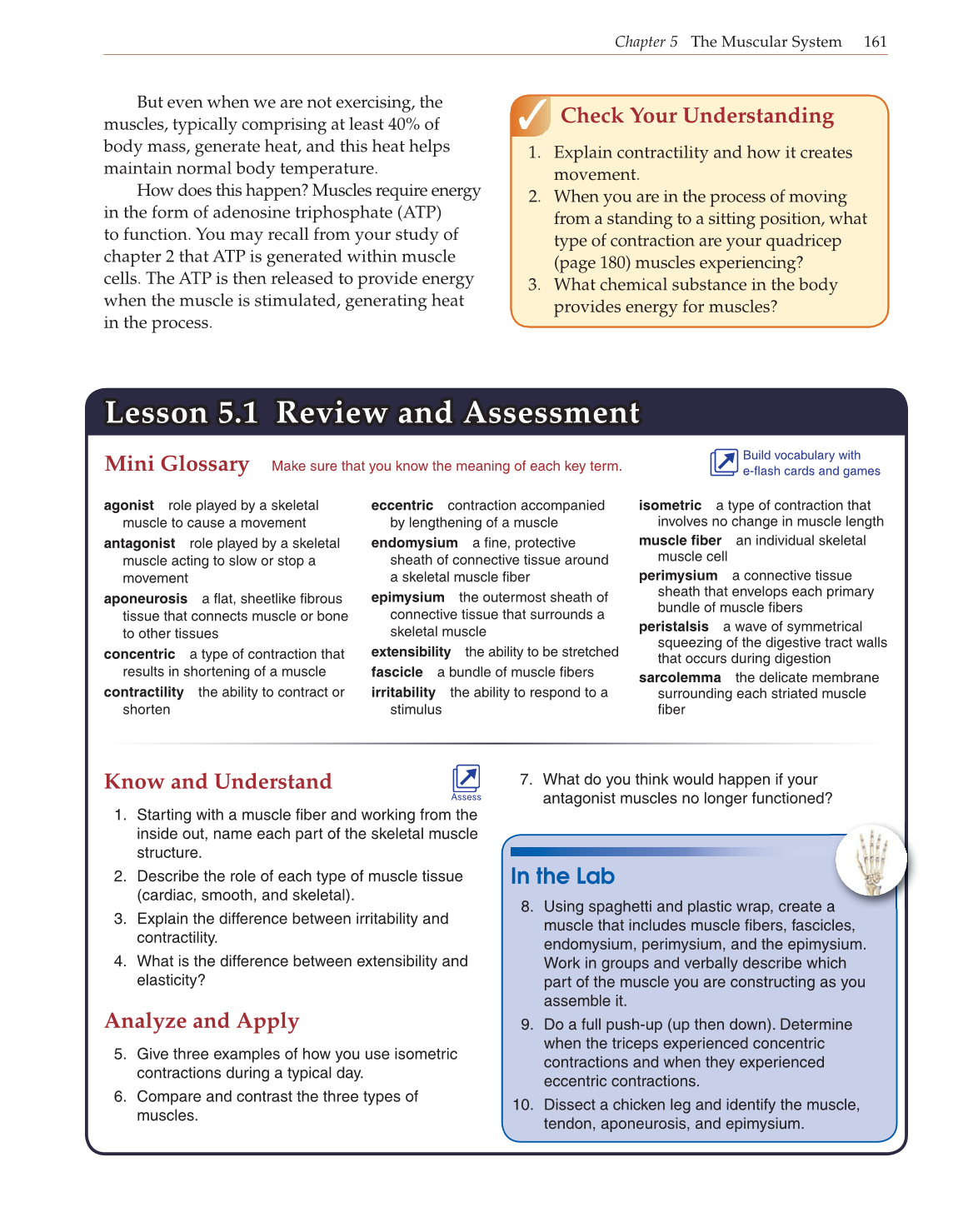Chapter 5 The Muscular System 161
But even when we are not exercising, the
muscles, typically comprising at least 40% of
body mass, generate heat, and this heat helps
maintain normal body temperature.
How does this happen? Muscles require energy
in the form of adenosine triphosphate (ATP)
to function. You may recall from your study of
chapter 2 that ATP is generated within muscle
cells. The ATP is then released to provide energy
when the muscle is stimulated, generating heat
in the process.
Lesson 5.1 Review and Assessment Lesson 5.1 Review and Assessment
Mini Glossary
Make sure that you know the meaning of each key term.
agonist role played by a skeletal
muscle to cause a movement
antagonist role played by a skeletal
muscle acting to slow or stop a
movement
aponeurosis a fl at, sheetlike fi brous
tissue that connects muscle or bone
to other tissues
concentric a type of contraction that
results in shortening of a muscle
contractility the ability to contract or
shorten
eccentric contraction accompanied
by lengthening of a muscle
endomysium a fi ne, protective
sheath of connective tissue around
a skeletal muscle fi ber
epimysium the outermost sheath of
connective tissue that surrounds a
skeletal muscle
extensibility the ability to be stretched
fascicle a bundle of muscle fi bers
irritability the ability to respond to a
stimulus
isometric a type of contraction that
involves no change in muscle length
muscle fi ber an individual skeletal
muscle cell
perimysium a connective tissue
sheath that envelops each primary
bundle of muscle fi bers
peristalsis a wave of symmetrical
squeezing of the digestive tract walls
that occurs during digestion
sarcolemma the delicate membrane
surrounding each striated muscle
fi ber
Build vocabulary with
e-fl ash cards and games
Know and Understand
1. Starting with a muscle fi ber and working from the
inside out, name each part of the skeletal muscle
structure.
2. Describe the role of each type of muscle tissue
(cardiac, smooth, and skeletal).
3. Explain the difference between irritability and
contractility.
4. What is the difference between extensibility and
elasticity?
Analyze and Apply
5. Give three examples of how you use isometric
contractions during a typical day.
6. Compare and contrast the three types of
muscles.
7. What do you think would happen if your
antagonist muscles no longer functioned?
8. Using spaghetti and plastic wrap, create a
muscle that includes muscle fi bers, fascicles,
endomysium, perimysium, and the epimysium.
Work in groups and verbally describe which
part of the muscle you are constructing as you
assemble it.
9. Do a full push-up (up then down). Determine
when the triceps experienced concentric
contractions and when they experienced
eccentric contractions.
10. Dissect a chicken leg and identify the muscle,
tendon, aponeurosis, and epimysium.
In the Lab
a
Assess
1. Explain contractility and how it creates
movement.
2. When you are in the process of moving
from a standing to a sitting position, what
type of contraction are your quadricep
(page 180) muscles experiencing?
3. What chemical substance in the body
provides energy for muscles?
Check Your Understanding
